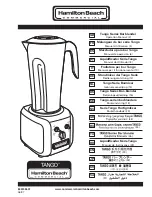
54 / 96
9.2 Trouble-shooting: frequency inverter
WARNING
Improper work to remedy faults
Risk of injury!
Ø
For any work performed to remedy faults, observe the relevant information
given in this operating manual and/or in the product literature provided by
the accessories manufacturer.
If problems occur that are not described in the following table, consultation with the DP
service is required.
A
Mains fuse rating too small for the nominal mains current.
B
Motor does not start.
C
Motor running unevenly.
D
Max. speed not reached.
E
Motor running at maximum speed only.
F
Motor running at minimum speed only.
G
No/faulty 24 V supply.
H
Wrong direction of rotation of the motor.
I
Fault message/protective tripping.
Table 22:
Trouble-shooting
A B C D
E
F
G H
I
Possible cause
Remedy
-
✘
-
-
-
-
✘
-
-
No voltage
Check the mains voltage; check the mains fuses.
-
✘
-
-
-
-
-
-
-
No enable
Check enable via DIGIN-EN and system start.
✘
-
-
-
-
-
-
-
-
Mains fuse rating too small for
frequency inverter input current
Check configuration/selection of mains fuse.
-
-
-
✘
-
-
-
-
-
No setpoint signal or setpoint set
too low / drive overloaded and in
i
2
t control mode
Check setpoint signal and operating point.
-
-
-
-
✘
-
-
-
-
Process-related persistent
control deviation (actual value
smaller than setpoint) or no
actual value (e.g. due to broken
wire)
Check setpoint signal/actual value signal. Check
operating point. Check controller setting.
-
✘
-
-
-
-
-
-
-
✘ Permissible voltage range
undershot/exceeded
Check mains voltage; supply frequency inverter with
required voltage.
-
-
-
-
-
-
-
✘
-
Wrong direction of rotation
setting
Change the direction of rotation.
-
-
✘
✘
-
-
-
-
✘ Frequency inverter overloaded
Reduce the power input by lowering the speed; check the
motor/pump for blockages.
-
✘
-
-
-
-
-
-
✘ Short circuit in control cable/
pump blocked
Check/replace control cable connections. Remove the
blockage manually.
-
-
✘
✘
-
-
-
-
✘ Temperature of power
electronics or stator winding too
high
Reduce the ambient temperature.
– Improve ventilation.
– Clean cooling fins.
– Ensure that the intake opening for the fans is not
blocked.
– Ensure that the fans are working properly.
– Reduce the power input by changing the operating
point (system-specific).
– Check the permissible load and, if necessary, use
external cooling.
Summary of Contents for Hydro-Unit Utility Line F
Page 29: ...29 96 1 2 Fig 12 PE connection 1 Earthing terminal 2 Location of power connection ...
Page 58: ...58 96 ...
Page 92: ...92 96 T Tank 79 Timers 73 W Warnings 9 Warranty claims 7 ...
Page 93: ......
Page 94: ......
Page 95: ......
















































